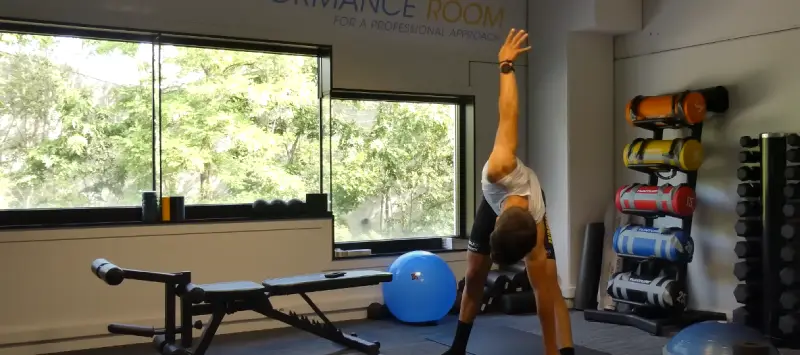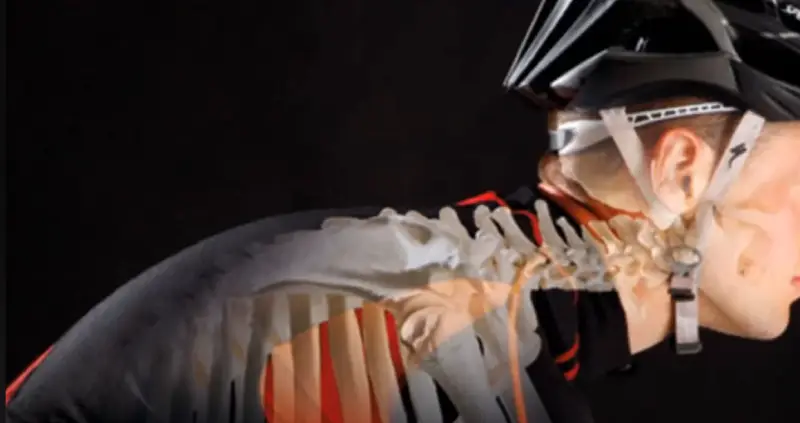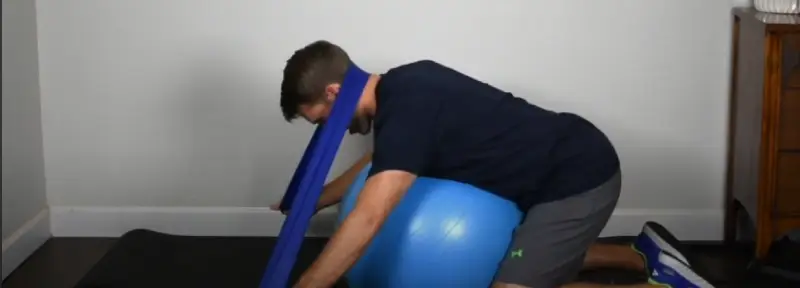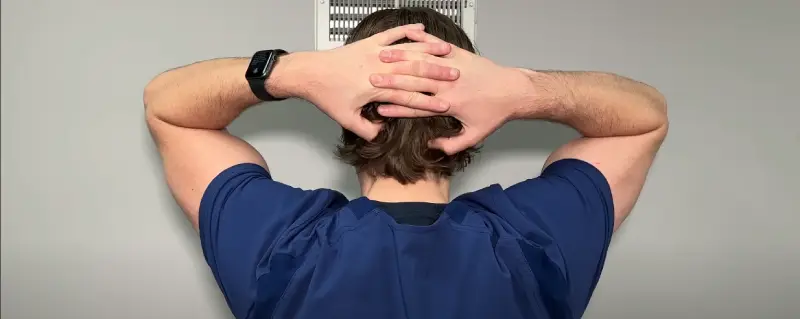Cycling can lead to nerve injuries in the neck, causing symptoms like numbness, pain, and muscle weakness. These injuries are often because of compression of the median and ulnar nerves, resulting in paresthesia.
Cyclists should gently massage the muscles around the neck and spine in circular motions to relieve a pinched nerve. To ease the pressure, perform chin tucks and shoulder blade squeezes. For relief and mobility, incorporate trap stretches and chin tucks with extension.
This blog post will provide 6 easy steps and post-massage care for massaging the pinched nerve in a cyclist’s neck.
How To Massage Pinched Nerve in Neck for Cyclist: Top 5 Tips

Cycling is excellent exercise but can sometimes cause pinched nerves in the neck. Proper massage techniques can help you recover faster. Here are the steps to massage your neck to relieve pinched nerves.
Preparing for The Massage
Before starting the massage, it’s important to prepare adequately to ensure comfort and effectiveness.
Identifying the Affected Area
Before you massage, it’s crucial to find exactly where the pinched nerve is. This will help you target the right spot and make the massage more effective. Techniques to Locate the Exact Spot:
- Move your neck slowly from side to side and notice where the pain is the worst.
- Press gently around your neck and shoulders to feel for tender or tight spots.
- Use a mirror or ask a friend to help identify swelling or redness.
Materials Needed
Gathering suitable materials will make the massage more comfortable and practical.
- Massage Oil: Makes your hands glide smoothly over your skin.
- Towel: Useful for cleaning up excess oil and keeping the area dry.
- Ergonomic Chair or Comfortable Surface: During the massage, ensure you have a stable and comfortable place to sit or lie down.
Setting Up a Relaxing Environment
Creating a calming space can make the massage more pleasant and help your muscles relax.
- Find a room where you won’t be disturbed.
- Make sure it’s a place where you feel relaxed.
- Use soft lighting to create a calm atmosphere.
- Adjust the room temperature to a comfortable level.
- Play some gentle music if you like.
- Sounds of nature or instrumental music can help you relax more deeply.
Warm-Up Techniques

Warming up the muscles in your neck before the massage can make the process more effective and less painful.
Gentle Stretching
Before you massage, it’s helpful to stretch your neck gently. This helps prepare the muscles and makes the massage more effective. Specific Neck Stretches to Prepare the Muscles:
- Side-to-Side Stretch: Gently tilt your head towards each shoulder.
- Forward and Backward Stretch: Slowly nod your head forward and backward.
- Rotational Stretch: Carefully turn your head left and right.
Heat Application
Applying heat before the massage can help relax the muscles and reduce pain. The following steps will help you relax your muscles:
- Warm Towel or Heating Pad: Apply it to the affected area for 10-15 minutes.
- Hot Shower: A warm shower can also relax the muscles and make them easier to massage.
Starting with Light Pressure
Begin your massage with light pressure to ease into the process and help relax the muscles around the affected area.
- Use gentle circular motions: Move your fingers around the pinched nerve in small circles.
- Duration: Spend 3-5 minutes doing this to help relax the muscles.
Applying Moderate Pressure
Once the muscles have relaxed, you can apply moderate pressure.
- Gradually increase pressure: Use your fingers or thumbs to press slightly harder on the areas where you feel tension and knots.
- Focus on tense areas: Concentrate on the spots that feel tight or painful.
Using Specific Techniques
You can use several specific massage techniques to relieve the pinched nerve effectively.
Kneading
Kneading helps to relieve muscle tension by manipulating the soft tissues.
- Description of kneading motions: Use your hands to grab and squeeze the muscles around the neck gently.
Deep Tissue Massage
This technique involves applying deeper pressure to target the pinched nerve directly.
- Instructions for deep tissue massage: Press firmly with your thumbs to reach deeper muscle layers, but be careful not to cause pain.
Trigger Point Therapy
Trigger points are specific spots within muscles that can cause pain in other body parts.
- Identifying trigger points: Look for areas that feel particularly tight or tender.
- Applying pressure to trigger points: Use your fingers to apply steady pressure to these points for a few seconds.
Finishing with Light Strokes
End the massage with light strokes to soothe the area and improve blood circulation.
- Gentle, sweeping motions: Use your palms to make gentle sweeping gestures across the neck.
- Duration: Spend about 2-3 minutes cooling down the area.
A Pinched Nerve in the Neck for Cyclists: Post-Massage Care

After massaging a pinched nerve, it’s crucial to take steps to care for your body to maintain the benefits of the massage.
Stretching
Stretching helps maintain flexibility and prevents the recurrence of neck pain. Recommended post-massage stretches:
- Slowly turn your head towards each shoulder to stretch the sides of your neck.
- Gently turn your head from left to right to increase mobility.
- Perform shoulder rolls to release any remaining tension in your neck and shoulders.
Hydration
You should drink water to flush out the toxins released during the massage. Importance of hydration:
- Stay hydrated after your massage to help your body eliminate toxins.
- Staying hydrated aids muscle recovery and reduces soreness.
Rest and Recovery
Taking it easy for a few hours after the massage allows your body to recover. Advising rest:
- Avoid any strenuous activities for a few hours post-massage.
- Allow your muscles to relax and heal for better results.
Additional Tips for Cyclists
Taking additional steps can help you prevent neck pain and avoid pinched nerves in the future.
Proper Bike Fit
Ensuring your bike is adjusted correctly can prevent neck strain. Bike fit tips:
- Make sure your bike’s seat height and handlebar position are correct.
- A proper bike fit helps disperse weight and reduce neck strain.
Posture Correction
Maintaining good posture while cycling is key to avoiding future pinched nerves. Posture tips:
- Keep your back straight and shoulders relaxed.
- Focus on smooth pedaling to minimize unnecessary tension in your neck.
Regular Breaks
Taking regular breaks during long rides helps keep your muscles flexible. Break advice:
- Stop every hour to stretch and move around.
- Regular breaks help prevent stiffness and maintain muscle flexibility.
Conclusion
A pinched nerve in your neck doesn’t have to derail your cycling passion. Following these massage techniques and incorporating good self-care practices can reduce discomfort and prevent future issues.
Regularly addressing muscle tension and maintaining proper posture on your bike is critical to staying pain-free and enjoying every ride.
FAQs
What Part Of The Neck Should Not Be Massaged?
A neck’s anterior and posterior triangles should never be massaged, as they contain vital glands like the thyroid and parathyroid. Because of their complex structures, massaging these areas can pose risks. It’s best to avoid applying pressure to these regions to prevent harm.


